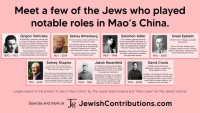vo golema mera e napraveno toa. vidi gi platite i standardot u kina denes, u meksiko e poevtino da proizevduvas nego u kina...Со крајот на глобализацијата, и посебно тарифите на Трамп, Кина растот на економијата нема да може да го темели само на извозот.
Тоа значи ќе треба да изврши трансформација на економијата.
CN – Народна Република Кина
- Креатор на темата Таксист
- Време на започнување
The xx
Russia state-affiliated bot. ☑️
- Член од
- 8 април 2013
- Мислења
- 7.567
- Поени од реакции
- 14.583
Целта на Сад е да се забави цела глобална економија, со крајна цел да се забави економијта на Кина. Не гледаш никаква паника нема од државниот врв во Сад иско берзата им е веќе месец дена во црвено. Какви еден може и два.Со крајот на глобализацијата, и посебно тарифите на Трамп, Кина растот на економијата нема да може да го темели само на извозот.
Тоа значи ќе треба да изврши трансформација на економијата.
Викаш ова не е точно:на евреите им е голема главоболка Кина, каде што влијанието не можат да го шират. Затоа мислам дека и Трамп многу го шилчат против Кинезите. Иако и они не се некои цвеќиња, но сепак еден евреј таму нема стапнато да шири отровот.

Grigorii Gershuni, Grigorii Voitinski, Boris Shumiatsky, Michail Borodin, Adolf Joffe, Pavel Mif, David Crook, Sidney Rittenberg, Israel Epstein, Sidney Shapiro, Solomon Adler, Sam Ginsbourg, Michael Shapiro...
Како Кина дошла до финансии за да дојде до сегашната позиција... како Кина успеала да дојде до технологија...Among “importers” of anarchism to Japan and, indirectly, to China (and East Asia), was a Jewish Lithuanian activist, Grigory Gershuni. Unlike leading Chinese anarchists who were intellectuals and theoreticians (Zarrow, 1990), Gershuni became a professional anarchist. Although, like other Jewish revolutionaries, he totally absorbed Russian culture, he was still proud of his Jewish origins and ability to fight antisemitism, using violence if needed. A founder of the Workers’ Party for the Political Liberation of Russia, in 1901, after his arrest, he became a co-founder of the Social-Revolutionary (SR) Party. In 1902, he launched the Party’s Combat Organization, which engaged in assassinations and terrorist acts. Betrayed by one of his “colleagues”, he was arrested in 1903, and a year later exiled to a prison (a labour camp) in east Siberia in the region of Nerchinsk (Gershuni, 2015: xi, xvi; 1919; Viktor, 1934). Before his arrest, he agreed to a “temporary alliance with the Constitutional Democrats (Geifman, 1993: 339).” In 1906, stuck in a barrel of sauerkraut, he escaped to China and thence to Japan. There, he met 1904-05 Russo-Japanese War prisoners, and Asian activists (like Sun Yat-sen) (Crump, 1983: 218-221, 236). This was perhaps the first time that Asian “revolutionaries” became familiar with practical anarchism. Socialism was less attractive because it did not relate to nationalism and lacked the organizational tools of making revolution. Gershuni offered some of the tools, turning anarchism into the most popular Western ideology in early 20th century East Asia. Yet, shortly, anarchism was outpaced by Leninism, which handed solutions to both hurdles: nationalism and organization – thereby triggering Chinese communism and launching the most remarkable event in Chinese history, to this very day. Gershuni had failed because he promoted only one aspect of the revolution, the destructive rather than the constructive. Initially impressed, Chinese radicals later found it negative and unacceptable
- Член од
- 29 јуни 2014
- Мислења
- 26.974
- Поени од реакции
- 43.962
бафра, комунистите се евреи без пари. Овие за кои зборам се оние со пари. Има огромна разлика меѓу едните и другите. Едните сакаат доминација врз масите преку контрола на власта, другите преку парите.Викаш ова не е точно:
Прегледај го приврзокот 447761
Како Кина дошла до финансии за да дојде до сегашната позиција... како Кина успеала да дојде до технологија...
Која е разликата, бидејќи велиш и едните и другите "сакаат доминација врз масите"бафра, комунистите се евреи без пари. Овие за кои зборам се оние со пари. Има огромна разлика меѓу едните и другите. Едните сакаат доминација врз масите преку контрола на власта, другите преку парите.
Помалку збори, почни да читаш и да размислуваш.
Како Кина дошла до финансии за да дојде до сегашната позиција
- Член од
- 29 јуни 2014
- Мислења
- 26.974
- Поени од реакции
- 43.962
Сега Кина нема ниеден евреј на никаква функција.Која е разликата, бидејќи велиш и едните и другите "сакаат доминација врз масите"
Помалку збори, почни да читаш и да размислуваш.
Сигурно ги избркале на клоци, исто како што во Русија не владеат. Едноставно ги снема, како што сатанистите ги снема, исчезнаа со доаѓањето на Трамп.Сега Кина нема ниеден евреј на никаква функција.
Мора да е така како што кажуваш, нели ти си познат по тоа што обработуваш многу информации и логички размислуваш.
Ете се виде дека е точно твоето тврдење "на евреите им е голема главоболка Кина, каде што влијанието не можат да го шират. Затоа мислам дека и Трамп многу го шилчат против Кинезите. Иако и они не се некои цвеќиња, но сепак еден евреј таму нема стапнато да шири отровот."
- Член од
- 29 јуни 2014
- Мислења
- 26.974
- Поени од реакции
- 43.962
Бафрич, знаеш има нешто што се вика историја. Слики од пред 70 години не се релевантни денес пошто времињата се смениле.Сигурно ги избркале на клоци, исто како што во Русија не владеат. Едноставно ги снема, како што сатанистите ги снема, исчезнаа со доаѓањето на Трамп.
Мора да е така како што кажуваш, нели ти си познат по тоа што обработуваш многу информации и логички размислуваш.
Ете се виде дека е точно твоето тврдење "на евреите им е голема главоболка Кина, каде што влијанието не можат да го шират. Затоа мислам дека и Трамп многу го шилчат против Кинезите. Иако и они не се некои цвеќиња, но сепак еден евреј таму нема стапнато да шири отровот."
А ти скаран со историја. Времињата се менуваат, ама тие се истите 4 годишни времиња. Но иако времињата се менуваат, забораваш на нешто што не се сменило 1000ци години, а тоа се човечките особини, па затоа сме сведоци на: историјата се повторува.Бафрич, знаеш има нешто што се вика историја. Слики од пред 70 години не се релевантни денес пошто времињата се смениле.
Сепак одамна се во Кина и не им е никаков проблем Кина како што првично тврдеше, за понатака продолжи си да бидеш ној.
- Член од
- 3 јуни 2022
- Мислења
- 1.920
- Поени од реакции
- 4.743
Кинезиве си газат, слични перформанси а многу пониски цени. Секако квалитетот е засега „спорен“ ама кога ќе ми текне и дека пред 3-4 години Дачиа дастер исто беше на лошо име се продаваше за 12-13к, сега истата е дупло откако не се покажа толку лошо


Investigation: is China’s motorcycle industry going to dominate?
Will China mimic Japan’s success half a century ago and supplant it as the cornerstone of the global motorcycle industry? We investigate.
www.bennetts.co.uk
kineskata era oficijalno zapocnuva
- Член од
- 23 мај 2019
- Мислења
- 4.799
- Поени од реакции
- 5.471
Велат една слика 1000 зборови, во случајов може се и повеќе.

и продолжетокот,


и продолжетокот,

- Член од
- 23 мај 2019
- Мислења
- 4.799
- Поени од реакции
- 5.471
Како кинескиот економски комунизам го освои светот
Ideologija kao alat: Kako je kineski gospodarski komunizam pokorio svijet

 www.geopolitika.news
www.geopolitika.news
Насловот директно удира на демократскиот свет, на потез се демократите
Демократите на апарати

Во текстот има еден куп податоци за економскиот бум на Кина а од истиот лесно може и да се направи предикција каде плива овој брод.
-гратис-

Ideologija kao alat: Kako je kineski gospodarski komunizam pokorio svijet

Ideologija kao alat: Kako je kineski gospodarski komunizam pokorio svijet | Geopolitika News
Kako objasniti grandiozni i globalni uspjeh KP Kine – može kroz više dimenzija, ekonomske, društvene,tehnološke, kulturne i ideološke — bez potrebe da se priklonimo narativima „Zapada“ ili „Istoka“.
 www.geopolitika.news
www.geopolitika.news
Насловот директно удира на демократскиот свет, на потез се демократите

Демократите на апарати


Во текстот има еден куп податоци за економскиот бум на Кина а од истиот лесно може и да се направи предикција каде плива овој брод.
-гратис-

- Член од
- 23 мај 2019
- Мислења
- 4.799
- Поени од реакции
- 5.471
Се надевам на поголем број им станува јасно дека светот на хегемонот ЕУСА завршува, ама не се давајте надежта умира последна.
Прозор во иднината!
China's Canton Fair 2025...America is Done! (tariffs not working)

 www.youtube.com
www.youtube.com
Семот се одржува 2 пати годишнбо (пролетен и есенски).
овде престанувам за да не се лутат демокративе атлантисти.
Прозор во иднината!
China's Canton Fair 2025...America is Done! (tariffs not working)

China is living in the future pt.2 | Canton Fair 2025
China is living in 2050—today! From autonomous sweeping robots to AI companions, robotic dogs doing backflips, and even surgical robots, the Canton Fair 2...
Семот се одржува 2 пати годишнбо (пролетен и есенски).
овде престанувам за да не се лутат демокративе атлантисти.

